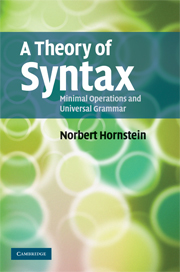Book contents
- Frontmatter
- Contents
- Preface
- 1 Minimalism and Darwin's Problem
- 2 Deriving c-command
- 3 Labels, recursion and movement
- 4 Some thoughts on adjunction
- 5 The emerging picture: Basic operations, FL and the Minimalist Program
- 6 Stop AGREEing! Keep Moving!
- 7 Conclusions, consequences and more questions
- References
- Index
4 - Some thoughts on adjunction
Published online by Cambridge University Press: 01 July 2009
- Frontmatter
- Contents
- Preface
- 1 Minimalism and Darwin's Problem
- 2 Deriving c-command
- 3 Labels, recursion and movement
- 4 Some thoughts on adjunction
- 5 The emerging picture: Basic operations, FL and the Minimalist Program
- 6 Stop AGREEing! Keep Moving!
- 7 Conclusions, consequences and more questions
- References
- Index
Summary
Introduction
It is fair to say that what adjuncts are and how they function grammatically is not well understood. The current wisdom comes in two parts: a description of some of the salient properties of adjuncts (they are optional, not generally selected, often display island (CED) effects, etc.) and a technology to code their presence (Chomsky-adjunction, different labels, etc). Within the Minimalist Program (MP), adjuncts have largely been treated as afterthoughts and this becomes evident when the technology deployed to accommodate them is carefully (or even cursorily) considered.
The primary aim of this chapter is to propose a phrase structure for adjunction that is compatible with the precepts of Bare Phrase Structure (BPS). Current accounts, I believe, are at odds with the central vision of BPS and current practice leans more to descriptive eclecticism than to theoretical insight. I have a diagnosis for this conceptual disarray. It stems from a deeply held though seldom formulated intuition; the tacit view that adjuncts are the abnormal case while arguments describe the grammatical norm. I suspect that this has it exactly backwards. In actuality, adjuncts are so well behaved that they require virtually no grammatical support to function properly. Arguments, in contrast, are refractory and require grammatical aid to allow them to make any propositional contribution. This last remark should come as no surprise to those with neo-Davidsonian semantic sympathies.
- Type
- Chapter
- Information
- A Theory of SyntaxMinimal Operations and Universal Grammar, pp. 81 - 105Publisher: Cambridge University PressPrint publication year: 2008



